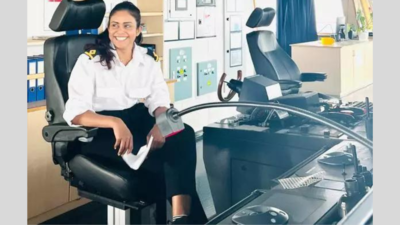- News
- City News
- mumbai News
- She rides over sea, and knows it’s not just a man’s world
Trending
She rides over sea, and knows it’s not just a man’s world
Lavanya, a Second Officer at Maersk, navigates life at sea, overcoming societal and professional hurdles. Inspired by stories from seafarers, she pursued Nautical Science against her father's initial opposition. Working on various ships, she balances her role as a navigator and a mother. Her story highlights the growing presence of women in maritime roles.
For centuries, the sea has been a man's world — rough, unpredictable, and dominated by an all-male crew. But times are changing. Women are stepping aboard, steering ships, and challenging the notion that the ocean is no place for them.
One such trailblazer is Lavanya (38), a Second Officer at Maersk. But her journey to the high seas wasn't smooth sailing. From the start, she encountered doubts — some from society, some from her own family, and many from male colleagues who questioned whether a woman could handle life at sea.
"The moment you step onto a ship as a woman, there's this unsaid expectation that you have to work twice as hard to prove yourself," says Lavanya. "Some men would openly question, ‘Women will show us how to run a ship?' Others didn't like taking instructions from a woman. I used to feel the pressure, but I realised that my work would speak for itself."
Her story began in an unexpected place — a dance studio in Delhi. While pursuing a BA in mathematics and human resources at Delhi University in 2005, she took up salsa classes, where she encountered several seafarers. Their accounts of travel and life at sea piqued her interest. "It sounded exciting because it was so different from my dad's banking job. No one in my family was in this profession," she says. "It was also fascinating because it was a uniform job and allowed me to explore the world."
She later joined Maersk as a Third Mate during Covid-19 pandemic, a time of unprecedented disruptions in the shipping industry. Rising to Second Officer, she took charge of navigation, maintaining charts, overseeing equipment, and standing watch from midnight to 4am and noon to 4pm. Off-watch, she handled inventory, requisitions, and was responsible for life-saving appliances like lifeboats and immersion suits.
Life at sea meant long stretches away from family. “Once, I was at sea for nine months straight,” she says. “Seafarers don’t make many friends because we are socially isolated. When we are sailing, a lot happens beyond the sea, and we often struggle to find common topics to discuss.”
At ports, her duties shift to maintaining port watches, assisting in cargo and ballast operations, and handling anchoring and mooring. The constant scrutiny of her gender in a physically demanding and highly technical job never fully fades, but she has learned to navigate it with confidence.
Yet, there are benefits. “Unlike many who commute daily and manage chores at home, when I’m on the ship, everything is taken care of—meals, accommodation, and even recreation,” she explains. “This allows me to save a lot of money—no travel costs, no dining-out expenses.”
Despite the hurdles, Lavanya built a successful career and met her husband, Sachin Bhardwaj, also a seafarer. Marriage and motherhood have not deterred her. “I’m currently on maternity leave and will rejoin a container ship in December,” she says.
When she started, there were few women in seafaring. Now, their numbers are rising. “The sea knows no gender—you have to navigate the ship in any weather condition,” says Lavanya.
Get the latest lifestyle updates on Times of India, along with Women's Day wishes, messages and quotes !

About the Author
Reeba ZachariahEnd of Article
FOLLOW US ON SOCIAL MEDIA








